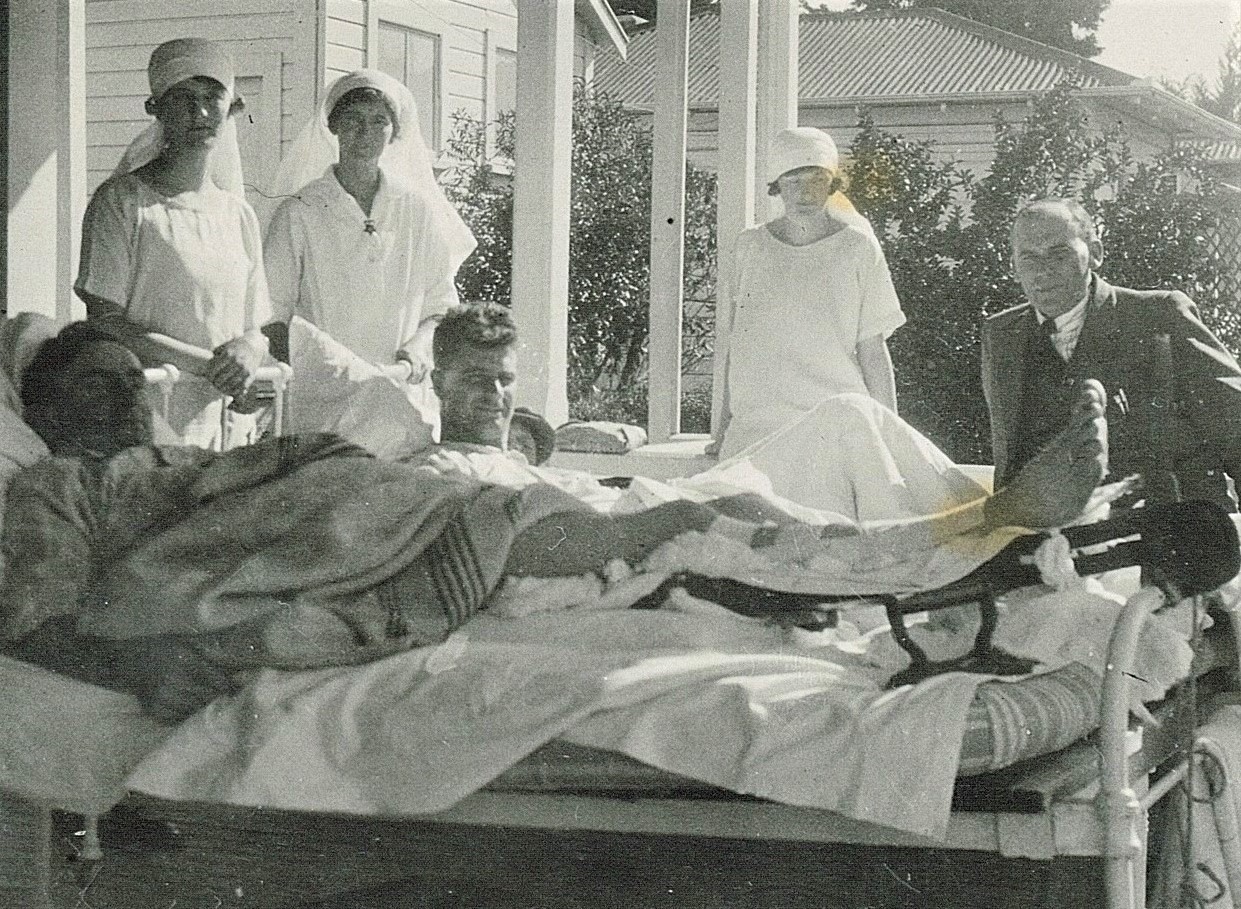Richmond Park emergency hospital 1918
In November 1918 a temporary emergency hospital was established at the A & P show grounds in Richmond. Lead by Mrs. Thomas, Dr. H. O. Washbourn and a band of volunteers the makeshift hospital treated local residents who had Influenza.
On 15 November 1918, with influenza patients crowding the fever ward and an overflow marque at Nelson Hospital, a decision was made to ask the Agricultural and Pastoral Association if they could make their Richmond grandstand available for use as a temporary emergency hospital. There were no ‘virulent cases’ of Spanish flu' in Richmond Borough at the time, but the situation in Waimea County was worse, and included twenty one of the twenty-four residents of Glenhope down with influenza. There were fears that many more could become ill.1
Richmond Park (the A&P Showgrounds) was the natural choice for the make-shift hospital. The property had multiple buildings including the brand-new grandstand as well as large grounds suitable for tents. It was isolated, so not an infection risk to nearby families, and was only a short distance from Richmond and the train station, so could be quickly stocked with medicines and other supplies.
Within a few days the hospital was set up in the large tearooms building at Richmond Park, and ready for patients by 20 November 1918. The large well-ventilated and well-lit room was divided into two wards with an initial capacity for fifteen patients in all, and plenty of extra space for additional beds if they were needed. Within a week fourteen of the beds were occupied.2
The Nelson Jockey Club rooms on site became the dorms for the nurses and cooking staff. Electric lighting was installed to the staff quarters, the hospital, kitchens and grounds by the Waimea Electric Light Company. Running water and even a bath for the staff were also quickly set up, as was a telephone connection. The Post Office telegraph engineers installed the telephone lines and got them working within eight hours of the initial request.3
The well-equipped hospital was presided over by Harriet Thomas (also known as Mrs. E. J. Thomas) and 'a band of willing voluntary workers'.4 Mrs. Thomas was already an experienced leader, having spent the war years organising functions and fundraising drives for the local branch of the Red Cross. The attending doctor was Dr. Hubert Oscar Washbourn. His offer to waive his usual fees and treat patients at the emergency hospital for free, as well as the volunteer labour force made the hospital more affordable to poorer families, with a fee of 4s per day.5
Local residents donated lemons, eggs, milk, vegetables and other goods for the patients, and were also invited to donate cakes for the staff. A Nelson Mail article at the time praised 'the public spiritedness of Richmond citizens’ and the wise leadership of Dr. Washbourn and Mr. Wilkes (Richmond Borough Mayor) and the energy and labour of a host of workers. 6
After the initial wave of patients, influenza cases in the district quickly receded. The temporary hospital was closed and Richmond Park returned to its usual function in time to host for the delayed '26th Annual Show' on the 19 February 1919. A large picnic was held at Baigent's property in Wakefield as a thank you to the workers who helped at the hospital, and Mayor Wilkes gave a speech crediting the workers and the 'isolation method' for the successful treatment of thirty-two patients, with no deaths.7
July 2020
Updated, March 25, 2025
Story by: Tasman Libraries
Sources
- Influenza hospital report epidemic in Nelson. (1918, November 18). Nelson Evening Mail, p.4.
https://paperspast.natlib.govt.nz/newspapers/NEM19181118.2.25 -
Influenza Epidemic at Richmond. (1918, November 28). Nelson Evening Mail, p.6.
- Hospital report. (1918, November 20). Nelson Evening Mail, p.4.
https://paperspast.natlib.govt.nz/newspapers/NEM19181120.2.26.2 -
Richmond emergency hospital. (1918, November 23). Nelson Evening Mail, p.4.
- Richmond Temporary Hospital: fees for treatment (1919, January 21). Colonist, p.4.
- Richmond emergency hospital.
-
Country news. (1919, January 10). Colonist, p.7.
Further Sources
Books
- Honigsbaum, M. (2020). The pandemic century: a history of global contagion from the Spanish flu to Covid-19. W. H. Allen.
http://www.worldcat.org/oclc/1158588299 - Maclean, F. S. (1964). Challenge for health: A history of public health in New Zealand. Gov. Print. Pp.387-394.
http://www.worldcat.org/oclc/254465179 -
Rice, G., & Bryder, L. (2005). Black November: The 1918 influenza epidemic in New Zealand. Canterbury University Press, University of Canterbury.
https://search.worldcat.org/en/title/62901731 - Rice, G. (2018). That terrible time: Eye-witness accounts of the 1918 influenza pandemic in New Zealand. Hawthorne Press. Pp.115-118.
http://www.worldcat.org/oclc/1076255035 - Robinson, K. (2019). From the country to the town: a history of the Nelson A. & P. Association. Nelson Agricultural & Pastoral Association. Pp.54, 71-72.
http://www.worldcat.org/oclc/1134451702
Newspapers
- Fraser, K. & Handforth, S. (2018). Nelson's forgotten epidemic - 100 years on (abridged). Nelson Historical Society journal, 8(4). 14-25.
- Newman, T. (2020, May 2). Nelson's 1918 lockdown. Nelson Mail, p.13.
- Obituary: Dr. H. O. Washbourn. (1927, July 19). Nelson Evening Mail, p.4.
https://paperspast.natlib.govt.nz/newspapers/NEM19270719.2.42 - Rice, G. (2019). 2018 James Jenkins lecture: Nelson in the 1918 influenza pandemic. Nelson Historical Society journal, 8(5). 6-24.
- Stade, K. (2019). Influenza in service. Nelson Historical Society journal, 8(5). 25-30.
- W.D.F.U. Appleby Branch tribute to first President. (1935, February 13). Nelson Evening Mail, p.7.
https://paperspast.natlib.govt.nz/newspapers/NEM19350213.2.106
Websites
-
Ministry for Culture and Heritage. (2005). South Island influenza death rates. NZ History.
https://nzhistory.govt.nz/culture/influenza-pandemic/south-island-death-rates#nelson
Maps
- Saxton, D. (1984). Interview with Slater, L. [Transcript of tape recording]. Richmond Oral History Project, Richmond Borough Council. Richmond, New Zealand: p.1-3.
https://heritage.tasmanlibraries.govt.nz/nodes/view/5504 - Stratford, M. (1984). Interview with Slater, L. [Transcript of tape recording]. Richmond Oral History Project, Richmond Borough Council. Richmond, New Zealand: p.2-3.
https://heritage.tasmanlibraries.govt.nz/nodes/view/5507
